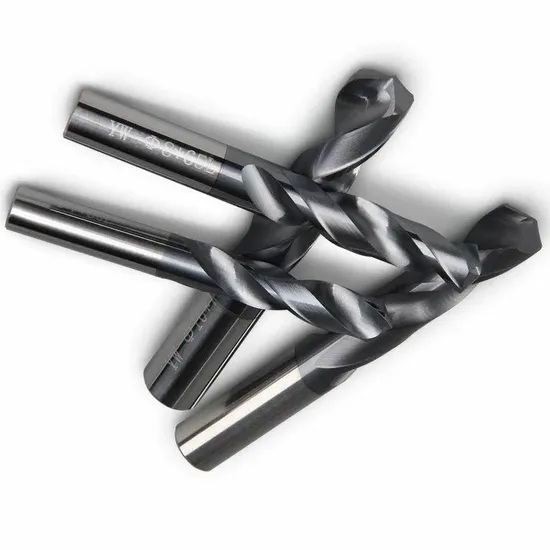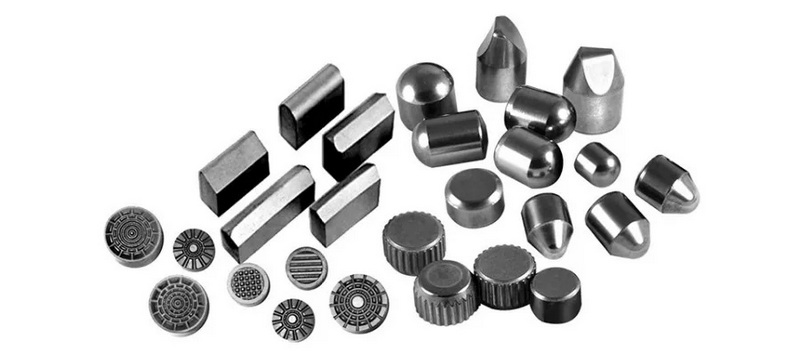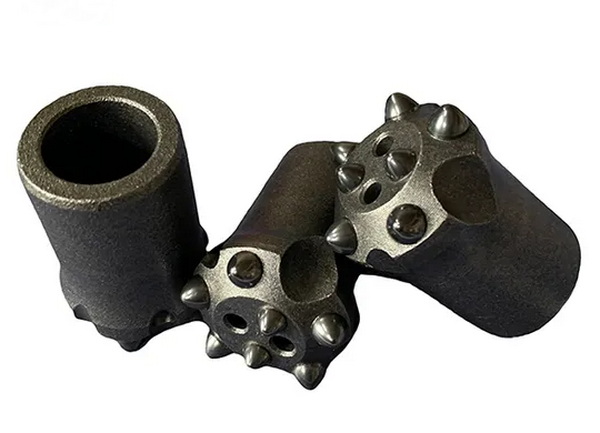Content Menu
● Introduction to Tungsten Carbide
>> Composition and Structure
>> Physical Properties
● Is Tungsten Carbide Non-Ferrous?
>> Non-Ferrous Metals Overview
>> Applications of Tungsten Carbide
● Production Process
>> Sintering Process
● Advanced Properties and Characteristics
>> Corrosion Resistance
>> Thermal Stability
>> Wear Resistance
● Different Grades and Compositions
>> Cemented Carbides
>> Grain Size
● Environmental Considerations
>> Mining of Tungsten
>> Recycling
● Future Trends
>> Nanomaterials
>> Additive Manufacturing
>> Alternative Binders
● Comparative Analysis with Other Materials
>> Tungsten Carbide vs. High-Speed Steel (HSS)
>> Tungsten Carbide vs. Ceramics
>> Tungsten Carbide vs. Diamond
● Practical Applications with Examples
● Conclusion
● FAQs
>> 1. What is Tungsten Carbide?
>> 2. Is Tungsten Carbide Non-Ferrous?
>> 3. What are the Primary Applications of Tungsten Carbide?
>> 4. How is Tungsten Carbide Produced?
>> 5. What are the Limitations of Tungsten Carbide?
● Citations:
Tungsten carbide, a compound of tungsten and carbon, is renowned for its exceptional hardness and durability. It is widely used in industrial applications, including cutting tools, drill bits, and wear-resistant components, as well as in jewelry due to its aesthetic appeal and durability. The question of whether tungsten carbide is non-ferrous involves understanding its composition and properties.

Introduction to Tungsten Carbide
Tungsten carbide (WC) is a chemical compound consisting of equal parts of tungsten and carbon atoms. It is produced through a process involving the reaction of tungsten metal with carbon at high temperatures, typically between 1,400°C and 2,000°C. The resulting material is extremely hard, with a Mohs hardness of 9 to 9.5, making it one of the hardest substances known, second only to diamond.
Composition and Structure
Tungsten carbide is primarily composed of tungsten and carbon. In its most common form, it is mixed with a binder metal, such as cobalt, to enhance its toughness and durability. This composite material is known as cemented carbide or hardmetal.
Composition:
- Tungsten (W): Provides hardness and wear resistance.
- Carbon (C): Contributes to the hardness and stability of the compound.
- Cobalt (Co): Acts as a binder, improving toughness and cohesion.
Physical Properties
Tungsten carbide exhibits several notable physical properties:
- Hardness: Ranks about 9 to 9.5 on the Mohs scale, making it extremely resistant to wear and abrasion.
- Density: Approximately twice that of steel, contributing to its high resistance to deformation.
- Melting Point: Over 2,870°C, which is significantly higher than most metals.
- Thermal Conductivity: High, allowing it to maintain sharp edges at elevated temperatures.
Is Tungsten Carbide Non-Ferrous?
Non-ferrous metals are those that do not contain iron. Tungsten carbide, being composed primarily of tungsten and carbon, with cobalt as a common binder, does not contain iron. Therefore, tungsten carbide is indeed a non-ferrous material.
Non-Ferrous Metals Overview
Non-ferrous metals include a wide range of materials such as aluminum, copper, zinc, and titanium. These metals are often used in applications where corrosion resistance or specific physical properties are required.
Non-Ferrous Metals:
- Aluminum (Al): Lightweight and corrosion-resistant.
- Copper (Cu): Excellent electrical conductivity.
- Zinc (Zn): Used in galvanizing to protect steel from corrosion.
- Titanium (Ti): High strength-to-weight ratio and corrosion resistance.
Applications of Tungsten Carbide
Tungsten carbide is utilized in various industries due to its hardness and durability:
1. Cutting Tools: Used in machining and drilling due to its ability to withstand high temperatures and maintain sharpness.
2. Jewelry: Popular for wedding bands and fashion rings due to its durability and aesthetic appeal.
3. Mining and Construction: Employed in wear parts for drilling and excavation equipment.
Production Process
The production of tungsten carbide involves several steps:
1. Synthesis of WC Powder: Tungsten metal reacts with carbon at high temperatures to form tungsten carbide powder.
2. Mixing with Binder: The WC powder is mixed with a binder metal, typically cobalt, to enhance toughness.
3. Sintering: The mixture is pressed and then heated to a high temperature (around 1,400°C to 1,600°C) to form a solid composite.
Sintering Process
The sintering process is crucial for creating a strong and cohesive material. It involves heating the mixture of tungsten carbide and cobalt to a temperature where the cobalt melts and binds the tungsten carbide grains together.
Detailed Steps of Sintering:
- Heating: The mixture is heated in a controlled atmosphere to prevent oxidation.
- Liquid Phase Sintering: The cobalt binder melts and flows between the tungsten carbide grains.
- Densification: The liquid cobalt pulls the tungsten carbide grains closer together, reducing porosity and increasing density.
- Cooling: The material is cooled slowly to prevent cracking and ensure uniform properties.
Advanced Properties and Characteristics
Tungsten carbide possesses a range of advanced properties and characteristics that make it suitable for specialized applications.
Corrosion Resistance
Tungsten carbide exhibits excellent corrosion resistance, particularly in acidic environments. This property makes it useful in chemical processing and marine applications where exposure to corrosive substances is common.
Thermal Stability
The high melting point of tungsten carbide contributes to its exceptional thermal stability. It can maintain its mechanical properties at elevated temperatures, making it suitable for high-speed cutting tools and aerospace components.
Wear Resistance
Its superior wear resistance makes tungsten carbide an ideal material for components subjected to constant friction and abrasion, such as bearings, seals, and nozzles.
Different Grades and Compositions
Tungsten carbide is available in various grades and compositions to suit different applications. The specific grade is determined by the ratio of tungsten carbide to binder metal and the size of the tungsten carbide grains.
Cemented Carbides
Cemented carbides consist of tungsten carbide grains embedded in a metallic binder matrix, typically cobalt. The amount of cobalt can vary from 3% to 25% by weight, depending on the desired properties.
Grain Size
The size of the tungsten carbide grains also affects the material's properties. Finer grains provide higher hardness and wear resistance, while coarser grains offer improved toughness and impact resistance.

Environmental Considerations
The production and use of tungsten carbide raise some environmental concerns.
Mining of Tungsten
Tungsten is often mined in environmentally sensitive areas, and the mining process can have significant impacts on local ecosystems. Responsible mining practices are essential to minimize these impacts.
Recycling
Recycling tungsten carbide is an important way to conserve resources and reduce environmental impacts. Recycling processes can recover tungsten and cobalt from used cutting tools and other components.
Future Trends
Several trends are shaping the future of tungsten carbide materials.
Nanomaterials
The use of nanomaterials is enhancing the properties of tungsten carbide composites. Nanoscale tungsten carbide grains can improve hardness and wear resistance.
Additive Manufacturing
Additive manufacturing techniques, such as 3D printing, are enabling the production of complex tungsten carbide components with customized designs.
Alternative Binders
Research is ongoing to develop alternative binder metals to replace cobalt, which is a strategic and expensive material. Nickel and iron-based alloys are being explored as potential replacements.
Comparative Analysis with Other Materials
To further understand the significance of tungsten carbide, it is beneficial to compare it with other common materials used in similar applications.
Tungsten Carbide vs. High-Speed Steel (HSS)
- Hardness: Tungsten carbide is significantly harder than HSS, offering superior wear resistance and longer tool life.
- Cost: HSS tools are generally less expensive than tungsten carbide tools.
- Applications: HSS is suitable for lower-speed cutting applications, while tungsten carbide is preferred for high-speed and high-precision machining.
Tungsten Carbide vs. Ceramics
- Hardness: Both tungsten carbide and ceramics offer high hardness, but tungsten carbide has better toughness and impact resistance.
- Brittleness: Ceramics are more brittle than tungsten carbide.
- Applications: Ceramics are used in high-temperature and corrosive environments, while tungsten carbide is used in applications requiring high wear resistance and toughness.
Tungsten Carbide vs. Diamond
- Hardness: Diamond is the hardest known material, but tungsten carbide offers a good balance of hardness and toughness.
- Cost: Diamond tools are significantly more expensive than tungsten carbide tools.
- Applications: Diamond is used for extremely hard materials and high-precision grinding, while tungsten carbide is used for a wider range of cutting and wear applications.
Practical Applications with Examples
To illustrate the practical use of tungsten carbide, consider the following applications:
1. Oil and Gas Industry:
- Drill Bits: Tungsten carbide inserts are used in drill bits for oil and gas exploration due to their ability to withstand high pressures and temperatures.
- Wear Components: Components like valve seats and pump plungers are made from tungsten carbide to resist abrasion from drilling fluids.
2. Automotive Industry:
- Cutting Tools: Used for machining engine components and transmission parts with high precision and efficiency.
- Tire Studs: Tungsten carbide studs are embedded in tires to improve traction on ice and snow.
3. Aerospace Industry:
- Turbine Blades: Used in turbine blades for jet engines due to their ability to maintain strength at high temperatures.
- Landing Gear Components: Wear-resistant coatings of tungsten carbide are applied to landing gear components to extend their lifespan.
4. Electronics Industry:
- Die Cutting Tools: Used for precision cutting and shaping of electronic components.
- Wire Drawing Dies: Tungsten carbide dies are used for drawing wires to precise diameters.
These examples demonstrate the versatility and importance of tungsten carbide across various industries. Its unique combination of properties makes it an indispensable material for demanding applications.
Conclusion
Tungsten carbide is a non-ferrous material due to its composition of tungsten and carbon, with cobalt as a common binder. Its exceptional hardness, durability, and resistance to wear make it invaluable in industrial applications and jewelry. The sintering process, along with various grades and compositions, allows for tailoring the material to specific needs. While challenges such as brittleness and environmental considerations exist, ongoing research and technological advancements continue to expand its applications. Tungsten carbide remains a vital material for modern technology and manufacturing.

FAQs
1. What is Tungsten Carbide?
Tungsten carbide is a chemical compound made from tungsten and carbon, known for its exceptional hardness and durability. It is widely used in cutting tools and jewelry.
2. Is Tungsten Carbide Non-Ferrous?
Yes, tungsten carbide is non-ferrous because it does not contain iron. It is composed primarily of tungsten and carbon, with cobalt often used as a binder.
3. What are the Primary Applications of Tungsten Carbide?
Tungsten carbide is primarily used in cutting tools, drill bits, and wear-resistant components due to its hardness and durability. It is also popular in jewelry for its aesthetic appeal and longevity.
4. How is Tungsten Carbide Produced?
Tungsten carbide is produced by reacting tungsten with carbon at high temperatures to form WC powder. This powder is then mixed with a binder, typically cobalt, and sintered to form a solid composite.
5. What are the Limitations of Tungsten Carbide?
Tungsten carbide is brittle and can crack under impact. Additionally, it is more expensive than many other materials due to the high cost of its raw materials and the complex production process.
Citations:
[1] https://en.wikipedia.org/wiki/Tungsten_carbide
[2] https://carbideprocessors.com/pages/carbide-parts/tungsten-carbide-properties.html
[3] https://www.superabrasivespowder.com/news/tungsten-carbide-classification.html
[4] https://www.allied-material.co.jp/en/techinfo/tungsten_carbide/features.html
[5] https://www.itia.info/applications-markets/
[6] https://www.alamy.com/stock-photo/tungsten-carbide.html
[7] https://www.retopz.com/57-frequently-asked-questions-faqs-about-tungsten-carbide/
[8] https://www.thermalspray.com/questions-tungsten-carbide/
[9] http://www.carbidetechnologies.com/faqs/
[10] https://www.twi-global.com/technical-knowledge/faqs/what-metals-are-non-ferrous
[11] https://shop.machinemfg.com/the-pros-and-cons-of-tungsten-carbide-a-comprehensive-guide/
[12] https://www.tungco.com/insights/blog/frequently-asked-questions-used-tungsten-carbide-inserts/
[13] http://machinetoolrecyclers.com/rita_hayworth.html
[14] https://eternaltools.com/blogs/tutorials/tungsten-carbide-an-informative-guide
[15] https://de.pferd.com/en/tungsten-carbide-burrs-for-high-performance-non-ferrous-cylindrical-shape-zya-without-end-cut?a%5Bdiam-shank-tds%5D=6+mm&a%5Bdiam-outer-tds%5D=12+mm&a%5Blength-cut-tds%5D=25+mm&a%5Blength-overall-tds%5D=65+mm
[16] http://www.tungsten-carbide.com.cn/tungsten-carbide-grade.html
[17] https://www.blecher.com/en/products/tungsten-carbide-tipped-circular-saw-blades-for-non-ferrous-metals/
[18] https://santoo-seals.com/non-ferrous-metal-steel-balls/
[19] https://fr.pferd.com/en/tungsten-carbide-burrs-for-high-performance-non-ferrous-conical-shape-with-radius-end-kel?a%5Bdiam-shank-tds%5D=8+mm&a%5Bdiam-outer-tds%5D=16+mm&a%5Blength-cut-tds%5D=30+mm&a%5Blength-overall-tds%5D=70+mm
[20] https://www.allied-material.co.jp/en/techinfo/tungsten_carbide/use.html
[21] https://www.matweb.com/search/DataSheet.aspx?MatGUID=e68b647b86104478a32012cbbd5ad3ea
[22] https://carbide-usa.com/top-5-uses-for-tungsten-carbide/
[23] https://www.freepik.com/free-photos-vectors/tungsten
[24] https://www.istockphoto.com/photos/tungsten-carbide
[25] https://stock.adobe.com/search?k=tungsten+carbide
[26] http://www.kovametalli-in.com/properties.html
[27] https://www.tungstenrepublic.com/Tungsten-Carbide-Rings-FAQ.html
[28] https://eternaltungsten.com/Frequently-Asked-Questions-FAQs
[29] https://consolidatedresources.com/blog/10-facts-about-tungsten-carbide/
[30] https://tuncomfg.com/about/faq/
[31] http://www.chinatungsten.com/Ferrous-Metal.html
[32] https://www.linde-amt.com/resource-library/articles/tungsten-carbide
[33] https://eurobalt.net/blog/2022/03/28/all-the-applications-of-tungsten-carbide/
[34] https://www.carbideprobes.com/wp-content/uploads/2019/07/TungstenCarbideDataSheet.pdf
[35] https://www.tungco.com/insights/blog/5-tungsten-carbide-applications/
[36] https://create.vista.com/photos/tungsten-carbide/
[37] https://www.gettyimages.hk/%E5%9C%96%E7%89%87/tungsten-carbide?page=2
[38] http://www.tungsten-carbide.com.cn
[39] http://www.chinatungsten.com/Tungsten-Carbide/Properties-of-Tungsten-Carbide.html
















